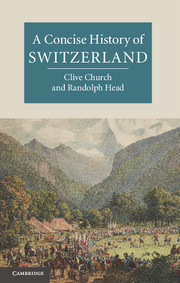Book contents
- Frontmatter
- Contents
- List of Illustrations
- List of Figures
- List of Maps
- Acknowledgements
- List of Abbreviations
- Introduction Making the Swiss
- 1 Before Switzerland
- 2 Creating the Swiss Confederacy, 1386–1520
- 3 A divided Switzerland in Reformation Europe, 1515–1713
- 4 The Ancien Régime, 1713–1798
- 5 Revolution and contention, 1798–1848
- 6 Forging the new nation, 1848–1914
- 7 The shocks of war, 1914–1950
- 8 The Sonderfall years, 1950–1990
- 9 Since 1989
- Chronology
- Glossary
- Further Reading
- Index
2 - Creating the Swiss Confederacy, 1386–1520
Published online by Cambridge University Press: 05 June 2013
- Frontmatter
- Contents
- List of Illustrations
- List of Figures
- List of Maps
- Acknowledgements
- List of Abbreviations
- Introduction Making the Swiss
- 1 Before Switzerland
- 2 Creating the Swiss Confederacy, 1386–1520
- 3 A divided Switzerland in Reformation Europe, 1515–1713
- 4 The Ancien Régime, 1713–1798
- 5 Revolution and contention, 1798–1848
- 6 Forging the new nation, 1848–1914
- 7 The shocks of war, 1914–1950
- 8 The Sonderfall years, 1950–1990
- 9 Since 1989
- Chronology
- Glossary
- Further Reading
- Index
Summary
Around 1400, the loosely organized Eidgenossenschaft or Confederacy of rural and urban communes, bolstered by mutual support at moments of crisis and by a few agreements on jurisdiction and military affairs, had become significant political players in the region stretching from Lake Geneva to Lake Constance. A century later c. 1500, a widely recognized Swiss Confederacy negotiated treaties with the Habsburg Emperors, the kings of France and other major European powers about military cooperation and dominion over northern Italy. Repeated wars as well as profound changes in the European political milieu and in relations among the Swiss themselves made this unexpected transformation possible.
Across Europe, leagues that began as desperate efforts to control violence in the High Middle Ages showed themselves capable – especially in Italy, the western German lands and the Netherlands – of evolving into stable political alliances with offensive and defensive capacities. The thriving Italian city-states in the fourteenth century proved that communal polities could become politically dominant; as they demonstrated in the fifteenth century, they could also produce new nobilities and revert to aristocratic government. The Eidgenossenschaft of the Swiss followed a different path. The small size of the units involved – Zurich and Berne were tiny compared to Florence and Milan – and the combination of rural and urban communes made the Swiss Confederacy distinctive. Moreover, aristocratic dynasties remained vital in the north beyond 1400, including the Habsburgs and Savoy along with regional houses like the Toggenburg and Württemberg, meaning that the Confederacy’s members could survive only through cooperation and mutual support. By 1500, however, despite the persistently diverse interests among its members, it was the Confederacy as a whole, rather than Berne or Zurich or Schwyz, that had become significant on a European scale.
- Type
- Chapter
- Information
- A Concise History of Switzerland , pp. 40 - 72Publisher: Cambridge University PressPrint publication year: 2013

